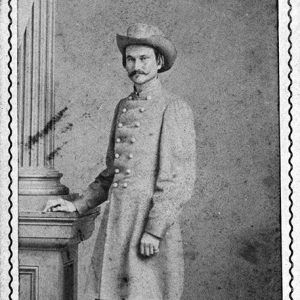calsfoundation@cals.org
Twelfth Arkansas Infantry (CS)
The Twelfth Arkansas Infantry Regiment was a Confederate unit that served in both the Western and Trans-Mississippi theaters during the American Civil War. Composed of companies and men primarily from Clark, Columbia, Dallas, Hempstead, Hot Spring, Ouachita, and Sevier counties, the regiment was organized on July 27, 1861, in Arkadelphia (Clark County) by Congressman Edward Gantt. The troops elected Gantt as colonel, W. D. Cook as lieutenant colonel, and Thomas J. Reid as major.
The regiment crossed the Mississippi River and garrisoned Columbus, Kentucky, during the Battle of Belmont in Missouri. Afterward, it transferred to New Madrid, Missouri, serving as garrison of Fort Thompson, along with the Eleventh Arkansas Infantry, operating as pickets in front of New Madrid. In March 1862, Union forces under Brigadier General John Pope began operations to implement a siege against New Madrid. By early March, with his guns in position, Pope opened the first artillery attack on Confederate forces holding Fort Thompson. Brigadier General John P. McCown decided to evacuate on March 13 and relocated the regiment to the east bank of the Mississippi River. Union gunboats passed Island No. 10 on April 4 and 6, forcing a Confederate retreat. Finding that Pope’s forces had crossed and cut them off to the south, the entire Confederate force was surrendered on April 8, 1862. Men of the Twelfth Arkansas were sent to northern military prisons, primarily Camp Douglas and Camp Butler, Illinois, and Johnson’s Island, Ohio.
However, a number of men, including the majority in companies D and K, escaped the surrender and were consolidated into three Arkansas regiments. One group was organized into the Sixth Arkansas Infantry, fighting in the central Kentucky Campaign with Lieutenant General Braxton Bragg’s forces in the fall, returning to the regiment in December 1862. Other members joined the newly organized Twenty-Fourth Arkansas Infantry and the Thirty-Third Arkansas Infantry at Camp White Sulphur Springs, with most never returning to the Twelfth Arkansas.
Upon release from prison, the regiment was paroled and exchanged at Vicksburg, Mississippi, and temporarily reorganized and placed under command of Colonel John L. Logan of the Eleventh Arkansas until regimental officers returned from recruiting in Arkansas. A disgruntled Colonel Gantt, accused of drunkenness and flirting with officers’ wives, resigned, and Major Reid was promoted to command. Upon return of the officers and recruits, the regiment moved to Port Hudson and was assigned to Brigadier General William Beall’s brigade, which held the left wing of the Port Hudson defenses. The Twelfth Arkansas endured heavy combat during a forty-eight-day siege, often having to request mule or horse meat to survive. Port Hudson surrendered on July 9, 1863, as the last Confederate stronghold on the Mississippi River. The officers were sent to northern prison camps, while the enlisted men were exchanged and returned to Arkansas.
By September 1864, the Twelfth consolidated with other understrength commands consisting of the Eighth Arkansas Infantry Battalion, Twelfth Arkansas Infantry Battalion, Eighteenth Arkansas Infantry, and Twenty-Third Arkansas Infantry to form the Second Arkansas Consolidated Infantry under command of Colonel Thomas J. Reid Jr. Placed in McNair’s Arkansas Brigade of Churchill’s Division, 2nd Army Corps of the Army of the Trans-Mississippi, the remnant of the regiment saw no fighting for the remainder of the war. The final months of the war were spent garrisoning posts across south Arkansas at Monticello (Drew County) and Camden (Ouachita County) as well as Minden, Louisiana, before relocating to Marshall, Texas, in April 1865. When General Kirby Smith surrendered the department on May 26, 1865, the survivors of the Twelfth Arkansas were ordered to Shreveport, Louisiana, to receive their paroles; however, the regiment did not report but simply disbanded without formally surrendering. Most individually journeyed to their homes, receiving their paroles at various locations along the way.
For additional information:
Daniel, L. J., and L. N. Bock. Island No. 10: Struggle for the Mississippi Valley. Tuscaloosa: University of Alabama Press, 1996.
Hewitt, Lawrence Lee. Port Hudson, Confederate Bastion on the Mississippi. Baton Rouge, LA: Louisiana State University Press 1994.
Rushing, Anthony C. Ranks of Honor: A Regimental History of the Eleventh Arkansas Infantry Regiment and Poe’s Cavalry Battalion, C.S.A., 1861–1865. Little Rock: Eagle Press, 1990.
The War of the Rebellion: A Compilation of the Official Records of the Union and Confederate Armies. Washington DC: Government Printing Office, 1880–1901.
Anthony Rushing
Benton, Arkansas


 Will P. Donnell
Will P. Donnell  N. W. Stewart
N. W. Stewart 



Comments
No comments on this entry yet.